
Not too long ago, I picked up a copy of Pema Chödrön’s Start Where You Are from my favorite book store with one intention: to learn how to be more compassionate towards myself.
While it sounds selfish, I had no initial interest in further developing my compassion for others; I’ve always been compassionate by nature, immediately sensing the hurts of others and trying to offer the most appropriate help to the person in pain.
In fact, when I first moved to the city, I actually had a few breakdowns upon realizing the sheer vastness of the population in such a condensed area, resulting in people’s energy bouncing off of everyone else without halt and in horribly tight quarters. I could feel the pains of the masses coming at me rapid-fire, but couldn’t offer any kind of help because there are simply too many people hurting here, but mostly because one of the many unwritten rules of living in the city is that all persons should generally ignore each other.
So, all I could do was absorb all the hurt flying down every block until I wised up enough to harden and protect myself.
Truth be told, I was already familiar with some of Chödrön’s teachings and I even unknowingly practiced bits and pieces of the mind training she describes in this particular book, but again, I chose to read it specifically to gain some insights on offering compassion to myself. In light of my recently-realized-but-definitely-lifelong inability to forgive myself for just about anything, to say it was necessary would be an understatement.
I do most (if not all) of my reading on the subway. It’s the only time I get to be in one place for any significant amount of time when I’m not working or sleeping—both of which I’ve also done on the subway, though of course I always prefer to bury my nose in a good book.
I finished this precious little read in a few days and felt simultaneously baffled by and at ease with the teachings Chödrön describes. The tasks and concepts are often so simple that they can appear daunting at first. For example, I already understood—or so I thought—that the relationship we have with ourselves and the relationships we have with others are essentially the same, which was what led me to read this book in the first place: I wanted to figure out why I had such a hard time dealing with myself when I was so readily compassionate towards others and how I could reconcile those difficulties.
Lo and behold, within hours of having finished the book, the universe already had plans to put the teachings right in front of me, waving like mad just inches away from my face.
I was riding the subway home after a long day. It was just past the evening rush hour, so the trains were crowded, but not unbearably so. My nose was already buried in my next read (Women Who Run With the Wolves, in case you were wondering) as I stood in the middle section of the car, directly in front of and facing those sitting down, keeping farther away from the doors since I had quite a few stops to go. A tall, well-dressed and chicly made-up woman stood just off to my left. I adored her shoes, but noticed that the heel was pretty high and probably uncomfortable, so when the seat in front of where I stood opened up, I remained standing in anticipation that she would want to sit, which she did. And once she settled herself there, she immediately closed her eyes.
As I kept my nose in my book—this woman now sitting right in front of me, facing me—I peeled my eyes away from the words for just long enough to see her head bowing down, but not in the way that happens when a person falls asleep; both of her delicately manicured hands purposefully covered her temples and the top of her forehead, shielding her downward gaze from those of us nearby. A few people took a glance and noticed she must have been upset, but they just as quickly looked away and carried on with their music or reading or Instagramming or whatever, as per the unwritten rules of subway etiquette.
Sure enough, she shifted one hand down to her eyes to wipe a few tears—tears that she had desperately tried to prevent from falling—and at this point my chest was buzzing with pins and needles in the way it always does when I feel someone hurting.
Much to my surprise, without thinking, I closed my book. I stared at this woman and felt how intensely she was hurting without knowing anything about her, much less the source of her pain. All I knew was that she was hurting and that she had tried so hard to keep that hurt suppressed, but alas, the tears trickled down her lovely face, leaving wet marks on her cheekbones. Whatever she was experiencing had pushed her to the breaking point, though she maintained her efforts to control herself and wept in a silence I understood too well.
That’s when Pema’s words flashed in my head: “Exchanging yourself for others begins to occur when you can see where someone is because you’ve been there. It doesn’t happen because you’re better than they are but because human beings share the same stuff. The more you know your own, the more you’re going to understand others.”
In that moment of understanding, I looked at this woman and unquestionably saw myself. I saw all the times I’ve been walking down the street or sitting on the subway on the verge of tears, hoping I could keep it together until I could escape to somewhere more private—and believe me, it’s happened more times than I care to recall. I saw her stuff and I saw my stuff and in that moment, it all looked the same; perhaps different as it appears most directly in our lives, sure, but it’s the same stuff nevertheless.
I saw the pain in her guarded eyes and felt it in my bones and for the first time in a while, I felt strongly that I had to do something, which meant I would be breaking all the unwritten rules of subway etiquette.
But before I could think, without hesitation, I did just that. As the train pulled into my stop and the doors slid open, I broke all the rules, lightly touched the woman’s arm and said “I don’t mean to intrude, but take care of yourself.”
I smiled when I said it. She smiled back without saying a word just as I turned to get off the train and walk home.
I have no idea what she thought of the split-second interaction. I have no idea if she felt it was kind and comforting or if she felt it was unwarranted and nosy. I could have made her day or pissed her off or provoked any other range of emotions; I’ll never know for sure.
But as I walked the few blocks home from the station that night, Pema’s words popped into my head again and I learned everything I needed to learn from that moment: I said to this crying woman what I would want someone to say to me.
Take care of yourself. It wasn’t premeditated. I didn’t contemplate what I would say before saying it. I didn’t even know I’d say anything at all. But I did. I said exactly what I’ve always wanted to hear for myself—from myself—and perhaps that’s why it came so instinctively.
And just like that, I felt I’d unlocked a piece of compassion I hadn’t noticed or understood before; that in wishing wellbeing on another, I could recognize the same desire for myself—from myself—and that just as I did for this woman, I could vocalize that desire towards my own wellbeing too, because I’m no different from her. Our stuff is the same. Our tears, whether shed or held back, are the same. Our capacity to feel is the same. Our hiding places and our breaking points and our attempts at retracting what’s about to explode—they’re all the same.
And that’s when I understood the congruence of compassion for self and for others: If I could break the rules by closing my book and opening myself to this woman, I can break the long-held beliefs shrouded with guilt and regret that keep me excluded from my own compassionate care. I can open to myself just as I opened to this woman—this stranger on the subway—and I can say to myself what I so easily said to her.
I can say “take care of yourself” and know that I genuinely mean it, that I truly hope for my own wellbeing because I hope for the wellbeing of the crying stranger on the subway and we are intrinsically the same.
So, in what could be considered the least likely of situations to learn a thing or two about compassion—on a subway where I’m not supposed to look at or talk to anyone—I got exactly what I was looking for in picking up the book in the first place, though as I might have suspected, the lesson came in a way I didn’t see coming.
It’s not that I’m suddenly 100% more compassionate towards myself, because it’s certainly not a switch to turn on or off so easily; but perhaps it’s best to say I’m a little more awake and aware of the potential for self-compassion than I’d been before. By seeing myself in the crying stranger on the subway for whom I felt such undeniable compassion, I couldn’t help but do as Pema suggested and exchange myself for her in that situation—and in doing so, I couldn’t help but understand that I, too, can give myself that same sincerity through those simple, off-the-cuff words: Take care of yourself.
Perhaps this was the catalyst I’d needed to start saying it more. And perhaps, with a good and light-hearted conscious effort, this will be the way I start taking the words to heart. Regardless, this crying stranger on the subway (and Pema, of course) reminded me of all the things I’d forgotten over time out of perceived self-protection: that breaking points come with or without consent, that tears fall despite valiant efforts to choke them, that shit happens, that I’ve created some (most) of that shit and that because of and as a result of all this, I am human.
I am the crying stranger on the subway to whom I gave all my love and compassion in that split-second interaction, and while it certainly won’t happen over night, at least now I can see the potential for giving that same thing to myself—for being on both the giving and receiving ends of “take care of yourself” accompanied by a gentle touch to say “I understand, I’m here, I care.”
It will take time and practice and the frustrations of not-quite-there-yet, but I think it’s a habit worth making. And I think I’ve already started right where I was—on the subway, standing before the familiar tears of a stranger, reaching out to her and coming face to face with the notion that in doing so, I could also reach me.
Author: Sara Rodriguez
Editor: Renée Picard
Photo: Eutah Mizushima via Unsplash










Read 14 comments and reply